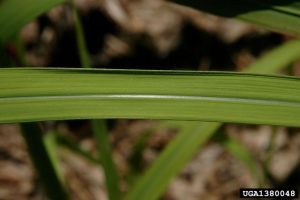Cogongrass (Imperata cylindrica) is a highly invasive species that poses significant threats to ecosystems worldwide. Native to Southeast Asia, it has spread to various parts of the world, including the southern United States, where it disrupts native flora, fuels wildfires, and degrades habitats. Proper identification of cogongrass is crucial for effective management and control efforts. Here’s a detailed guide on identifying this aggressive invader.
Physical Characteristics
Leaves
Shape and Size: Cogongrass leaves are long and narrow, typically ranging from 1 to 6 feet in length and about 1 inch in width.
Color: The leaves are usually a light green, turning brown in the fall and winter. The midrib (central vein) is white, prominent, and often off-center.
Edges: Leaf margins are rough and serrated, making them abrasive to the touch. Base: The base of the leaves is covered with fine hairs, which can be a distinguishing feature.

Flowers
Timing: Cogongrass blooms in late spring to early summer.
Appearance: The flower heads are cylindrical, fluffy, and white to silver, resembling a bottle brush and can contain up to 3,000 seeds. The silky-white hairs aid in wind dispersal. They can reach up to 8 inches in length and are often seen standing above the foliage.

Rhizomes
Structure: The rhizomes (underground stems) are another key identifying feature. They are tough, white, and have a very sharp point. At least 60% of the total plant biomass is often found below the soil surface.
Growth Pattern: The rhizomes grow horizontally, forming dense mats that make mechanical control challenging. They also allow the plant to spread rapidly.

Habitat and Growth Conditions
Preferred Environments
Soil Types: Cogongrass thrives in a variety of soils but prefers sandy and well-drained soils.
Sunlight: It grows best in full sunlight but can tolerate partial shade.
Moisture: It is drought-tolerant once established but also grows in moist environments.
Common Locations
Disturbed Areas: Cogongrass often invades disturbed sites such as roadsides, abandoned fields, forest edges, and areas cleared by fire or human activities.
Natural Ecosystems: It can encroach into natural habitats, outcompeting native plants and altering fire regimes. Cogongrass has been reported in all 67 counties within Florida.
Similar Species
Native Grasses
Big Bluestem (Andropogon gerardii): Often mistaken for cogongrass, big bluestem has a distinctive “turkey foot” seed head and a blue-green coloration.
Broomsedge (Andropogon virginicus): Broomsedge also has rough leaf edges but lacks the off-center midrib and hairy leaf base of cogon grass.
Non-Native Grasses
Johnsongrass (Sorghum halepense): This invasive grass has a prominent midrib, but its leaves are wider, and the plant has a distinctive sorghum-like seed head.
Control and Management
Preventative measures include decontamination of equipment before relocating. This is a critical step for preventing the spread of plant material as cogongrass can spread from seed and plant material.
Cultural/Physical Control
Mowing and Burning: Repeated mowing or prescribed burning can help manage cogongrass but must be combined with other methods to prevent regrowth from rhizomes. Do not mow when seed heads are present. Mowing and burning are often used before herbicide application. This helps remove built-up thatch and promote active growth herbicide uptake.
Mechanical Control
Disking and deep plowing: This method is effective in suppressing or eradicating cogongrass in intensive agricultural settings.
Chemical Control
Herbicides: Systemic herbicides like glyphosate and imazapyr can be effective but require careful application to minimize damage to non-target species. The use of herbicides requires an integrated and well-timed approach.
Biological Control
Research Efforts: Ongoing research is exploring potential biological control agents, but no widely effective biological controls are currently available.
See links below for more information regarding the management of Cogongrass. You can also contact your local UF/IFAS Extension office.
Cogongrass Management FAQ – Alabama Cooperative Extension System (aces.edu)
Impacts
Cogongrass is considered one of the world’s most problematic weeds, posing a significant threat to public and private forests, agricultural lands, and natural areas. What makes this invasive species so impactful? The key lies in its methods of spread. Cogongrass propagates through airborne seeds and highly efficient underground rhizomes. Additionally, it can easily be dispersed via contaminated equipment.
Identifying cogon grass involves looking for key characteristics such as its long, narrow leaves with off-center midribs, rough edges, and fluffy white flower heads. Understanding its preferred habitats and distinguishing it from similar species can aid in proper identification and management. By staying vigilant and employing effective control strategies, we can mitigate the impact of this invasive species on our ecosystems.
 1
1
